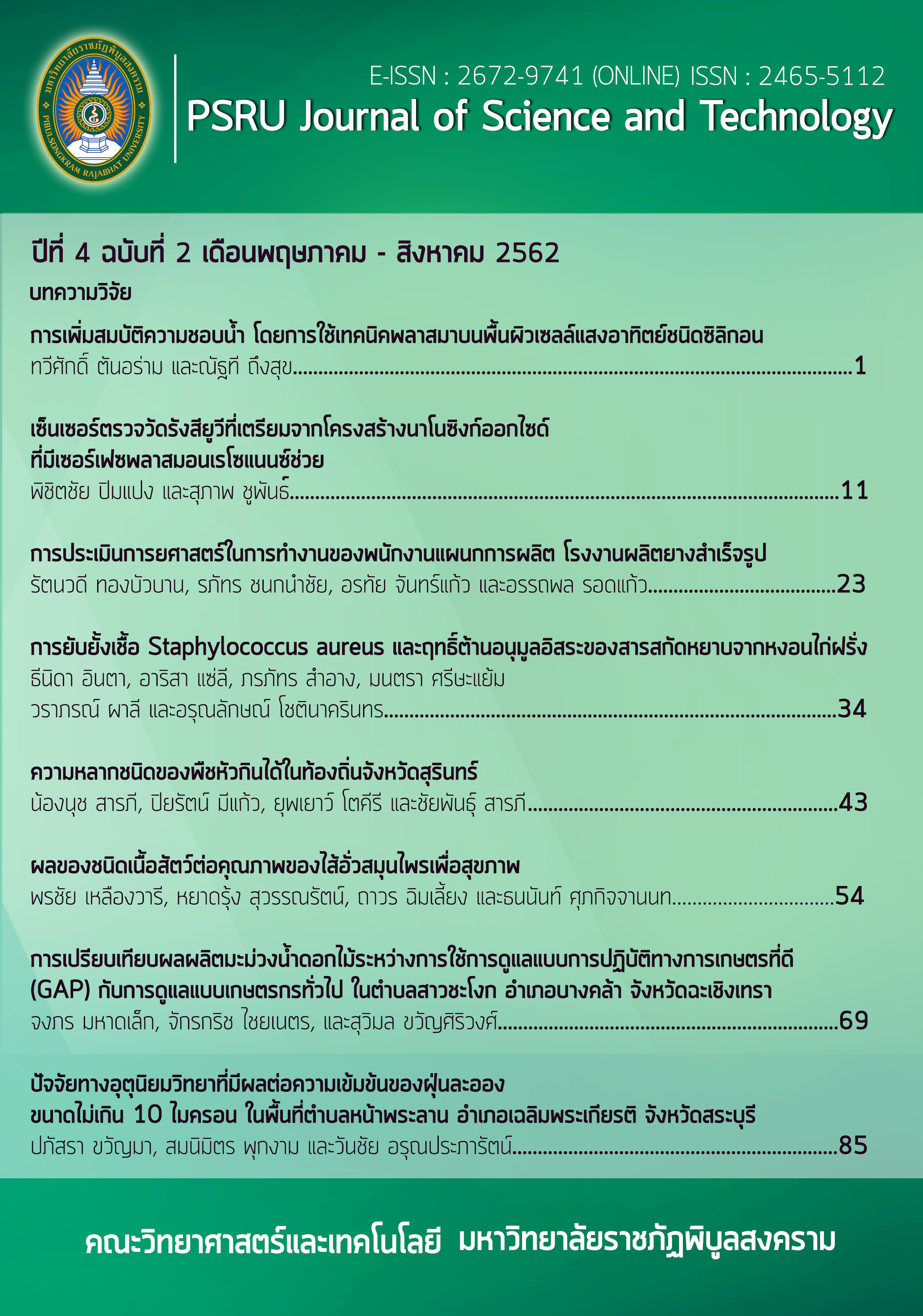THE IMPROVEMENT OF HYDROPHILIC PROPERTIES BY PLASMA TECHNIQUE ON SILICON PHOTOVOLTAIC SURFCE
Keywords:
Hydrophilic, Silicon surface, Plasma, PhotovoltaicAbstract
The improvement of hydrophilic properties have an impact to increase adhesives properties of silicon surface for photovoltaic could protect the moisture into the cell. In this research, the optimization of a low-pressure high-frequency plasma Chemical Vapor Deposition (CVD) system was studied an effect of a mixture of Argon and Nitrogen gas flow rates for hydrophilic characteristic. The three parameter with the time for plasma treatment, radio frequency (RF) power and a mixture of Argon and Nitrogen flow rates was investigated for propose system. The improved adhesive property of the surface was confirmed by using contact angle meter for measured the hydrophilic properties. It was found that the optimize parameters for the surface plasma treatment was 300 W RF power and 10 min on plasma treatment time, respectively The Argon and Nitrogen gas flow rate were 10.0 L/min and 0.4 L/min. It was also confirmed that the contact angle decreased from 35.9 to 12.8 degree. The nitrogen radicals react to silicon surface results in surface modification and therefore the adhesive property improved.
References
Fumiyoshi Tochikubo and Hideyuki Arai. (2002). Numerical Simulation of Streamer Propagation and Radical Reactions in Positive Corona Discharge in N2/NO and N2/O2/NO. Japanese Journal of Applied Physics, 41(2A), 844-852.
Ghada Dushaq, Mahmoud Rasras and Ammar Nayfeh. (2017). Low temperature deposition of germanium on silicon using Radio Frequency Plasma Enhanced Chemical Vapor Deposition. Thin Solid Films, 636, 585-592.
Huaquan Wang, Hongsheng Luo, Huankai Zhou, Xingdong Zhou, Xin Xing Zhang, Wenjing Lin, … Yihang Zhang. (2018). Dramatically enhanced strain- and moisture-sensitivity of bioinspired fragmentized carbon architectures regulated by cellulosenanocrystals. Chemical Engineering Journal, 345, 452-461.
J.K. Rath, M. Brinza, Y. Liu, A. Borreman and R.E.I. Schropp. (2010). Fabrication of thin film siliconsolar cells on plastic substrate by very high frequency PECVD. Solar Energy Materials and Solar Cells, 94 (9), 1534-1541.
Lin Weihao, Chen Shengnan, Wang Jianxun, Jia Shaohui, Song Chenlu, Liu Yong and Han Gaorong. (2018). Study on structural, optical and hydrophilic properties of FTO/TiO2 tandem thin film prepared by aerosol-assisted chemical vapor deposition method. Surface and Coatings Technology, 358.
Mohsen Heshmati, Reza Haghani and Mohammad Al-Emrani. (2016). Effects of moisture on the long-term performance of adhesively bonded FRP/steel joints used in bridges. Composites Part B, 92, 447-462.
N. Thungsuk, P. Nuchuay, D. Hirotani, Y. Okamura, K. Nakabayashi, H. Kinoshita, … N. Kasayapanand. (2014). Development of low-pressure high-Frequency plasma chemical vapor deposition method on surface modification of Silicon wafer. Vacuum, 109, 166-169.
N. Thungsuk, T. Yuji, N. Mungkung, Y. Okamura, A. Fujimaru, H. Kinoshita, D. Hirotani, … N. Kasayapanand. (2015). The Development of Polyethylene Naphthalate Films by Low-pressure High-frequency Plasma Chemical Vapor Deposition System with Advance Oxidations Process. Journal of Advanced Technologies, 18(1), 123-128.
Sanja Kostica, Vivian Merka, John K. Berga, Philipp Hassa, Ingo Burgerta and Etienne Cabanea. (2018). Timber-mortar composites: The effect of sol-gel Surface modification on the wood-adhesive interface. Composite Structures, 201, 828–833.
S. Nagashima, T. Hasebe, A. Kamijo, Y. Yoshimoto, A. Hotta, H. Morita, … Suzuki. (2010). Effect of oxygen plasma treatment on non-thrombogenicity of diamond-like carbon films. Diamond and Related Materials, 19(7–9), 861-865.
Tarun Singh Yadav, Ashok Kumar Sharma, Anil Kottantharayil and Prabir Kanti Basu. (2018). Low-cost and low-temperature chemical oxide passivation process for large area single crystalline silicon solar cells. Solar Energy, 169, 270-276.
T. Yuji, N. Mungkung, Y. Kiyota, D. Uesugi, M. Kawano, K. Nakabayashi, … H. Akatsuka. (2011). Surface Modification of Si Wafer by Low-Pressure High-Frequency Plasma Chemical Vapor Deposition Method. IEEE Trans. on Plasma Science, 39(6), 1427-1431.
Xizu Wang, Cindy Xinxin Zhao, Gu Xu, Zhi-Kuan Chen and Furong Zhu. (2012). Degradation mechanisms in organic solar cells: Localized moisture encroachment and cathode reaction. Solar Energy Materials and Solar Cells, 104, 1-6.
Downloads
Published
How to Cite
Issue
Section
License
กองบรรณาธิการขอสงวนสิทธิ์ในการปรับปรุงแก้ไขตัวอักษรและคำสะกดต่างๆ ที่ไม่ถูกต้อง และต้นฉบับที่ได้รับการตีพิมพ์ในวารสาร PSRU Journal of Science and Technology ถือเป็นกรรมสิทธิ์ของคณะวิทยาศาสตร์และเทคโนโลยี มหาวิทยาลัยราชภัฏพิบูลสงคราม และ
ผลการพิจารณาคัดเลือกบทความตีพิมพ์ในวารสารให้ถือมติของกองบรรณาธิการเป็นที่สิ้นสุด







